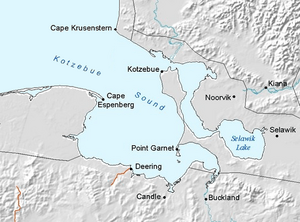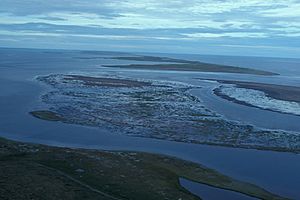Kotzebue Sound facts for kids
Kotzebue Sound (which is Kotsebu Zaliv in Russian) is a large arm of the Chukchi Sea. It is located in the western part of Alaska, a U.S. state. This sound is found north of the Seward Peninsula and has the Baldwin Peninsula to its east. It stretches about 100 miles (161 km) long and 70 miles (113 km) wide.
Weather and Seasons
Kotzebue Sound has a climate that changes between seasons. It has long, cold winters and cool summers. In January, the average low temperature is about -12°F (-24°C). In July, the average high temperature is around 58°F (14°C). The temperature can be as cold as -52°F (-47°C) or as warm as 85°F (29°C).
The area gets about 40 inches (1016 mm) of snow each year. The total rainfall is about 9 inches (229 mm) per year. Kotzebue Sound is usually free of ice from early July until early October.
Towns and History
Several towns are located along the shores of Kotzebue Sound. These include Kotzebue, Kiwalik, and Deering.
A Baltic German Lieutenant named Otto von Kotzebue explored this sound in 1816. He was working for Russia at the time. He named the sound after himself while he was looking for the Northeast Passage, a sea route connecting the Atlantic and Pacific oceans through the Arctic.
Animals of Kotzebue Sound
Kotzebue Sound is home to many different animals. You can find a wide variety of birds here. Some of these birds include the tufted puffin, the black-throated diver, and the red-throated loon.
The sound is also a place where polar bears (Ursus maritimus) live. In fact, the largest polar bear ever recorded was seen at Kotzebue Sound. This huge bear weighed 2,210 pounds (1,002 kg)!
See also
 In Spanish: Kotzebue Sound para niños
In Spanish: Kotzebue Sound para niños



